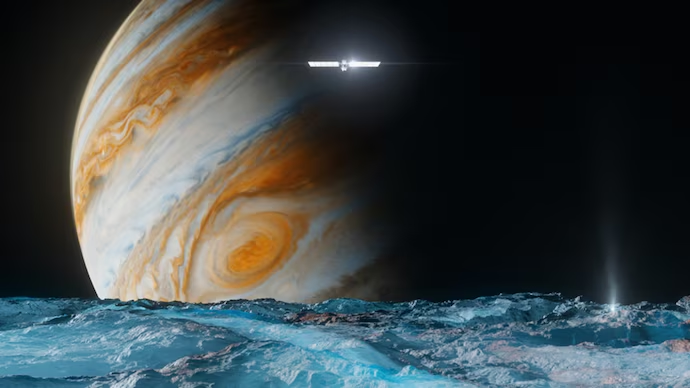Nasa Confirms Europa Clipper Mission to Visit Jupiter Moon for Signs of Life

NASA is about to make history while searching for alien life on Jupiter’s icy moon Europa The Europa Clipper spacecraft will search the moon for signs of life by examining its surface, water and power sources beneath a thick icy shell.
Europa Clipper aims for October 14th launch: A brief overview of the mission
A NASA mission called Europa Clipper is expected to launch from Florida on October 14 aboard SpaceX’s Falcon Heavy rocket. Lasting from 2015–2034, this long-term project is the first planned mission to Jupiter’s fourth largest moon, Europa by NASA!
The ambitious $5.2 billion mission seeks to find out if the subterranean ocean on Europa has the essential substances — water, energy and organic compounds — needed for life.
Europa — for an Ocean World Beneath Ice
Some scientists think one of the most promising places to go looking for life beyond Earth is Europa and its large salty ocean hidden beneath a thick layer of ice. “Europa is a very interesting place as an ocean world,” said Gina DiBraccio, director of NASA’s planetary science division.
During close flybys, the mission aims to investigate Europa’s environment and assess its habitability one of these days.
The Clipper Spacecraft:NASA’s Biggest Planetary Probe
The Europa Clipper clocks in at 100 feet long, and it is NASA’s largest spacecraft for a planetary mission. Outfitted with massive solar arrays to power its instruments far from the sun and designed to withstand Jupiter’s harsh environment, Juno will also carry a camera capable of taking high-resolution images during 33 close-in flybys.
Clipper will arrive at Jupiter and enter orbit in April 2030, following a journey of about five-and-a-half years to Europa.
Enduring the harsh radiation of Jupiter
The intense radiation around Jupiter — with a magnetic field 20,000 times stronger than Earth’s own magnetic field—is one of the biggest challenges for Juno. The craft is surrounded by a magnetic field, which traps dangerous high-energy particles that could fry its delicate electronics.
The Europa Clipper carries sophisticated shielding to protect against the radiation and its orbits are carefully designed so as not to pass through regions of maximum intensity.
Close Flybys to Collect Data
The Clipper will perform close flybys of Europa from Jupiter’s orbit with a minimum altitude as low as 16 miles (25 kilometers) above the moon. It will make close flybys to measure the moon’s environment in intricate detail and investigate whether there are any organic compounds or energy sources.
The Mission Timeline: 2015—2034
With the official close of Europa Clipper slated for June 2034, nearly two decades will have passed since this work began. If successful, this mission will provide answers to one of the most important questions in space travel – is Europa’s invisible ocean hiding life?
Follow shaktiexpress for getting a regular update of all that is happening in this thrilling mission.
